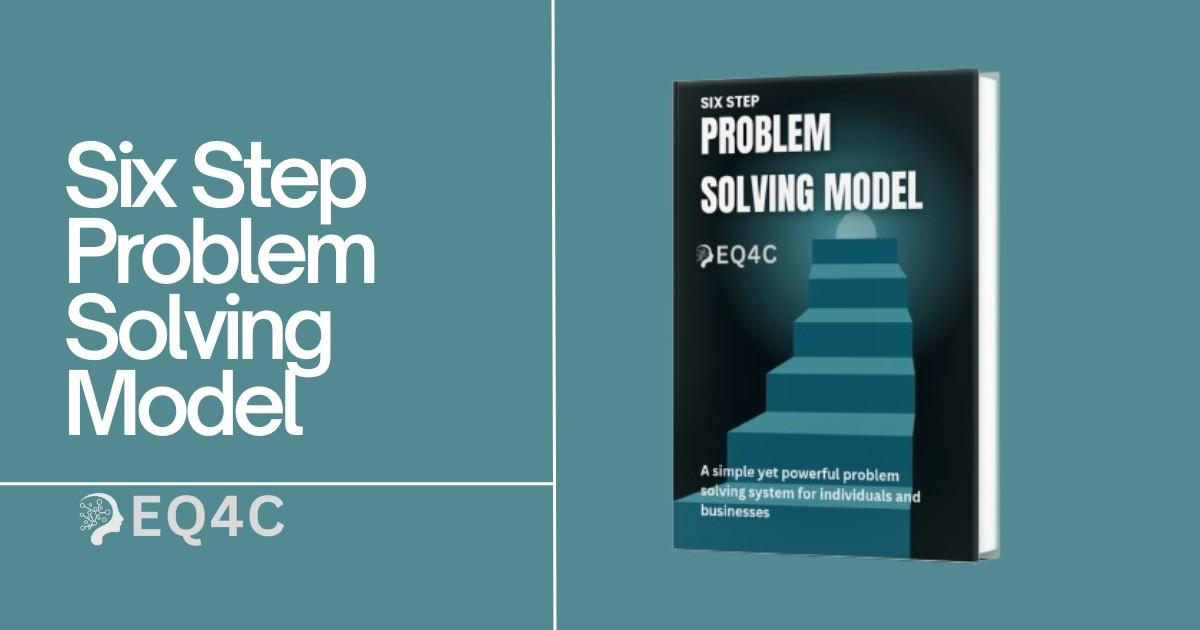The Six Step Problem Solving Model
Struggling to solve problems effectively? Read as we break down key problem-solving strategies to help you tackle challenges with confidence.

What is The Six Step Problem Solving Model?
The Six Step Problem Solving Model is a widely recognized and effective approach to addressing and resolving complex problems in personal and professional settings. This model provides a structured and systematic process for analyzing, identifying, and resolving issues, making it an indispensable tool for individuals, teams, and organizations.
Problem-solving is the process of identifying and resolving issues or obstacles that hinder the attainment of a goal. It is a critical skill that is highly valued in both personal and professional settings.
Whether you are a business owner, an employee, or an individual, the ability to solve problems effectively is essential for success.
According to a report by the World Economic Forum, problem-solving, critical thinking, and creativity are among the top skills that will be in demand in the job market by 2025.
This highlights the importance of problem-solving as a skill in the professional world. However, problem-solving is not limited to the workplace, it is also crucial in everyday life.
For instance, when faced with a personal challenge or a difficult situation, the ability to identify and solve the problem is key to achieving a desirable outcome.
The Six Step Problem Solving Model was first introduced by Kepner and Tregoe in the 1960s, who were management consultants known for their work in the field of decision-making and problem-solving. They proposed a rational and logical approach that was based on a rigorous analysis of the problem and its underlying causes, followed by a deliberate and careful selection of solutions that would address the root cause of the problem.
Since then, the Six Step Problem Solving Model has been widely adopted and modified by many organizations and industries, and it continues to be a useful and effective tool for addressing complex issues in a structured and systematic manner.
In this article, we will explore each step of the model in detail and provide examples of how it can be applied in real-world situations.
I have listed below all Six Steps in detail:
Step 1: Identify The Problem
Identifying the problem is the first step in the Six-Step Problem Solving Model. This step is critical because it sets the foundation for the rest of the problem-solving process.
The four sub-steps of this stage include:
Selection of the problem to be analyzed
The first sub-step in this stage is to select the problem that needs to be analyzed. This could be any issue that is causing problems for your personal or professional life. It could be a product or service that is not meeting customer expectations, a process that is causing delays, or any other problem that needs to be addressed.
Clear definition of the problem and establishment of a precise problem statement
Once you have identified the problem to be analyzed, the next step is to define it clearly and establish a precise problem statement. This step involves defining the problem in clear and concise terms so that everyone involved in the problem-solving process understands the issue at hand.
For example, if the problem is related to product quality, the problem statement could be: “Our product is not meeting the quality standards expected by our customers, which is resulting in negative feedback and decreased sales.”
Setting a measurable goal for the problem-solving effort
After defining the problem, the next step is to set a measurable goal for the problem-solving effort. This goal should be specific, measurable, achievable, relevant, and time-bound (SMART). The goal should be aligned with the overall objectives of the organization and should focus on addressing the root cause of the problem.
For example, if the problem is related to product quality, the goal could be: “To improve product quality by reducing defects by 50% within the next three months.”
Establishing a process for coordinating with and gaining approval of leadership
The final sub-step in this stage is to establish a process for coordinating with and gaining approval of leadership. This involves identifying the stakeholders who will be involved in the problem-solving process and obtaining their buy-in and support for the process.
For example, if the problem is related to product quality, the stakeholders could include the quality control team, production team, and senior management. It is important to involve all stakeholders in the process to ensure that everyone is aligned and committed to finding a solution to the problem.
Step 2: Analyze The Problem
Identification of the processes that impact the problem and selection of one
To analyze the problem effectively, you need to identify the processes that impact the problem and select one. The selected process should be relevant to the problem and the one that can be analyzed to identify the root cause.
For example, if a company is experiencing a high employee turnover rate, the process that needs to be analyzed could be the hiring process, employee training process, or employee feedback process.
Listing the steps in the process as it currently exists
Once you have identified the process, you need to list all the steps in the process as it currently exists. This will help you identify where the problem is occurring and what steps need to be changed to solve the problem.
For instance, in the case of employee turnover rate, the steps in the hiring process could be job posting, resume screening, initial interview, background check, reference check, and final interview.
Mapping the process
After listing the steps, you need to map the process. This involves creating a visual representation of the process flow. Mapping the process helps in identifying the bottlenecks, redundancies, and inefficiencies in the process.
Validation of the map of the process
The next step is to validate the map of the process. This involves reviewing the map with the stakeholders involved in the process and confirming that it accurately represents the process flow.
Identification of potential causes of the problem
With the process map validated, the next step is to identify potential causes of the problem. This can be done by brainstorming with the stakeholders and identifying the areas where the process is not functioning effectively.
For instance, in the hiring process, potential causes of employee turnover rate could be a lack of a comprehensive background check, inadequate employee training, or poor job fit.
Collection and analysis of data related to the problem
After identifying potential causes, you need to collect and analyze data related to the problem. This can include employee feedback surveys, turnover data, job satisfaction data, and any other relevant data.
Verification or revision of the original problem statement
Based on the analysis, you may need to verify or revise the original problem statement. This ensures that the problem statement accurately reflects the problem being solved.
Identification of root causes of the problem
With the data analyzed, you can identify the root causes of the problem. Root causes are the underlying reasons why the problem is occurring.
For example, in the hiring process, the root cause of employee turnover could be the inadequate employee training, which leads to employees feeling unprepared for the job.
Collection of additional data if needed to verify root causes
To verify the root causes identified, you may need to collect additional data. This ensures that the solutions developed address the actual root cause of the problem, leading to long-term and sustainable solutions.
The second step of the Six Step Problem Solving Model is critical in identifying the root cause of the problem. By analyzing the process and identifying potential causes and root causes, you can develop effective solutions to solve the problem.
Step 3: Develop The Solutions
After identifying the root causes of the problem, it’s time to develop solutions. This step involves the following:
Establishment of criteria for selecting a solution
When selecting a solution, it’s important to establish criteria that will help in evaluating and selecting the best solution. The criteria should be measurable, objective, and specific to the problem. Some criteria that can be used include:
- Feasibility: Can the solution be implemented with the available resources?
- Effectiveness: Will the solution solve the problem?
- Cost: Is the cost of the solution within the budget?
- Time: Will the solution be implemented within the required time frame?
Generation of potential solutions that will address the root causes of the problem
Brainstorming is a great way to generate potential solutions. Gather a team of individuals who are knowledgeable about the problem and its root causes. Encourage them to think creatively and come up with as many potential solutions as possible. It’s important to involve stakeholders who will be affected by the solution in the brainstorming process to ensure that their concerns are considered.
Use any of the 12 techniques of brainstorming from our brainstorming toolbox.
Selection of a solution
Once potential solutions have been generated, it’s time to select the best one. Use the established criteria to evaluate each solution and determine which one is the best fit. It’s important to involve stakeholders in the selection process to ensure buy-in and support for the chosen solution.
Gaining approval and support for the chosen solution
Before implementing the solution, it’s important to gain approval and support from leadership and other stakeholders. Present the chosen solution and its benefits to the decision-makers, and address any concerns they may have. Get their approval and support before moving forward with implementation.
Planning the solution
After gaining approval, it’s time to plan the solution. This involves creating an action plan that outlines the steps needed to implement the solution, who will be responsible for each step, and when each step will be completed. It’s important to have a realistic timeline and to involve all stakeholders in the planning process. Ensure that resources are available for implementation, and that all necessary training and communication plans are in place.
Step 4: Implement A Solution
Once the solution has been selected and approved, it’s time to put the plan into action. This step involves implementing the chosen solution on a trial or pilot basis to see how it performs. Here are the key components of this step:
Implementation of the chosen solution on a trial or pilot basis
Before implementing the solution fully, it’s important to test it out on a smaller scale to see how it works. This allows you to identify any potential problems or issues and make adjustments as needed. By implementing the solution on a trial or pilot basis, you can ensure that it will work effectively when it’s rolled out more broadly.
If the Problem Solving Process is being used as a standalone, continue to Step 5
If the Six Step Problem Solving Model is being used as a standalone process, it’s time to move on to Step 5, which involves evaluating the results of the solution. This step is critical to ensure that the solution is working as intended and achieving the desired results.
Step 5: Evaluate The Results
Gathering of data on the solution
Once the chosen solution has been implemented, it is important to gather data on its effectiveness. This data can come in various forms, such as customer feedback, sales figures, or productivity metrics. The key is to gather enough data to make an informed decision about the success or failure of the solution.
Analysis of the data on the solution
After collecting the necessary data, it is important to analyze it thoroughly to determine whether or not the solution has achieved the desired results. This analysis can involve statistical methods, surveys, or other evaluation techniques. The goal is to determine whether or not the solution has been successful and to identify any areas where improvements can be made.
Achievement of the desired results?
Based on the analysis of the data, it is necessary to determine whether or not the solution has achieved the desired results. This can involve comparing the actual results to the goals established in Step 1, or it can involve evaluating the overall impact of the solution on the organization or individual.
If YES, go to Step 6.
If the solution has achieved the desired results, it is time to move on to Step 6. This step involves standardizing the solution and capitalizing on any new opportunities that may have arisen as a result of the problem-solving process.
If NO, go back to Step 1.
If the solution has not achieved the desired results, it is necessary to go back to Step 1 and repeat the problem-solving process. This may involve refining the problem statement, identifying new potential causes, or generating new potential solutions. The key is to remain flexible and open to new ideas throughout the problem-solving process.
Step 6: Standardize The Solution (and Capitalize on New Opportunities)
Once the solution has been implemented and evaluated, it’s time to standardize the solution and capitalize on new opportunities. This step involves making sure that the solution is integrated into the organization’s standard operating procedures and that everyone involved knows how to use it effectively.
Identification of Systemic Changes and Training Needs for Full Implementation
When identifying systemic changes, it’s important to look at how the solution fits into the larger context of the organization. This includes looking at processes, policies, and procedures to see where changes need to be made to fully implement the solution.
Training is also crucial in the standardization process. Employees need to know how to use the solution properly and effectively. This can include training on new processes, tools, and technologies.
Adoption of the Solution
Once the solution has been standardized, it’s time to adopt it fully. This means integrating it into the organization’s operations and ensuring that everyone is using it consistently. This can involve making changes to job descriptions, updating policies and procedures, and making sure that everyone has the necessary tools and resources to use the solution effectively.
Planning Ongoing Monitoring of the Solution
Even after the solution has been adopted, it’s important to continue monitoring its effectiveness. This can involve setting up monitoring and reporting systems to track progress and identify areas for improvement. Regular review meetings can also help to keep the solution on track and ensure that it is meeting the organization’s goals and objectives.
Continuing to Look for Incremental Improvements to Refine the Solution
While the solution may have solved the initial problem, there is always room for improvement. This can involve looking for ways to make the solution more efficient, effective, or user-friendly. This can include gathering feedback from employees and customers, analyzing data to identify areas for improvement, and looking for ways to optimize processes and procedures.
Looking for Another Improvement Opportunity
Finally, it’s important to keep looking for new improvement opportunities. The Six Step Problem Solving Model is an iterative process, and there is always room for improvement. This can involve looking at other areas of the organization that could benefit from problem-solving and using the same process to identify and implement solutions.
Conclusion
In conclusion, the six-step problem-solving model is an effective approach for addressing problems and making improvements in personal and professional settings. The model involves identifying the problem, analyzing it, developing solutions, implementing the solution, evaluating the results, and standardizing the solution.
To summarize, the six steps of problem-solving include:
- Identify the problem
- Analyze the problem
- Develop the solutions
- Implement the solution
- Evaluate the results
- Standardize the solution (and capitalize on new opportunities)
Problem-solving and continuous improvement are critical skills for personal and professional growth.
By utilizing this model, individuals and organizations can become more efficient, productive, and effective in addressing challenges and achieving their goals.
Download free resources on this article:
- Cheat Sheet
- Video Link
- Work Sheet
- Real Life Case Studies
- Assessment Quiz
Enter your details and get a download link in your email:
- American Society for Quality. (2019). Root Cause Analysis.
- Hames, S. (2017). The 5 Whys Method
- Fass, M. (2020). The Six-Step Problem-Solving Process. Harvard Business Review.
- The Six-Step Problem-Solving Process by the University of California, San Francisco
- The Importance of Problem-Solving Skills in the Workplace by The Balance Careers.



